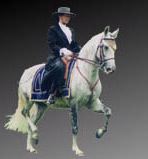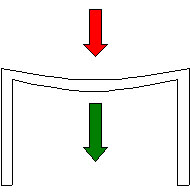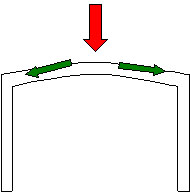 |
classicaldressagescotland.com |
| Lesson 1: Not a lot of people know that |
| New web address: www.classicaldressagescotland.com |  |
| About this site | About us | Personal Tuition | Video analysis | Lesson menu | Portugal and Lusitanos |
| Home Schooling Classical dressage Modern dressage Horse trials Show jumping Glossary Links |
On the Introduction to Classical Dressage
page (if you have read it) we said that classical training was
interested mainly in three things:
1. Training the horse to carry a rider. These are the things which we all wish for today, whatever our riding interest, and these are the things on which our training will concentrate at the beginning. Later lessons will deal with school and competition movements, dressage tests, display and demonstration riding, etc. But why are we interested in telling you about training your horse to carry a rider? Most people's horses have been broken and backed, possibly sold to you as an "experienced event horse" or with "brilliant potential in any sphere". Surely, they already know how to carry a rider. Many of the riding problems we see are because the rider does not know how the horse should best carry a rider You must understand how the horse can most comfortably carry the rider if you expect your horse to be obedient and responsive. Then you can ask your horse for what you want knowing that it will be able to respond easily and safely. If you do not know, the chances are that you are damaging your horse without knowing it and creating all kinds of problems for yourself in obedience. We do not want you to hurt your horse - and we know that you do not either! So read on... Every time you ride you are teaching your horse how to carry you - or more importantly, how to carry itself. If you do this correctly, you will allow your horse to be comfortable and balanced whilst carrying you. Of course, if you do this incorrectly, your horse will be uncomfortable and unhappy (though you will see this through stiffness or disobedience).Your horse must be comfortable and balanced whilst carrying you if you expect it to be able to do as you ask. So how can you help? In classical training and dressage, a lot is said about the horse being 'round' and 'on the bit'. These are very important things, but achieving them seems to be a mystery to many or something which you work for as a more advanced rider. When I ask even quite experienced riders why a horse should be 'on the bit', the most common reply I get is silence! What would your answer be? Occasionally people think it is because the horse looks more impressive, but most people simply do not know. This knowledge should be right at the beginning of learning to ride because a horse which is round and on the bit is one which is has adjusted itself to take the rider's weight and is free to be responsive to the rider's commands. Only once this has happened should you expect more work - otherwise you are being unfair to your horse. Why is this? Imagine that your horse is like a bridge. It's back will carry you and it's legs form the supports at each end. But the horse was not meant to carry an extra weight in the middle of its back. Its spine and musculature were designed to carry the weight of its body - not yours as well. One of the principles of classical dressage is that we train the horse to carry itself differently when carrying a rider. Why do we do this? Look at the simple diagrams below to understand.
With its back muscles braced to cope with your weight, the horse cannot carry you for long without getting tired and it cannot do what you might ask easily. So, we train the horse to carry itself differently when we are on its back to help it out...
This is why it is important for your horse to be round and on the bit. If we make it easier for the horse to carry us, our horse will be more comfortable and relaxed. There will be much less strain for the horse when we ride and we will allow it to be more responsive. A horse which carries its rider badly is under strain. It is tense and uncomfortable and likely to be evasive and disobedient - and who could blame it!!?? Understanding how your horse should carry you will allow your horse to be happier, healthier, and more likely to be willing and obedient. So how do we teach our horse to carry itself in a way which helps it carry its rider? This basic principle is covered in many of our lessons (such as Lesson Number 6 - On the Aids, Lesson Number 7 - On the Bit , Lesson Number 8 - Balance, Engagement and the Half-Halt and "Collection") and there is much more to it (such as shifting the horse's weight back towards the rear) but it begins with how we warm up or work-in the horse at the start of every schooling session. This is the subject of our next lesson.
|
 Your
weight adds to the horse's own weight and must be carried across
its back. To so do, the horse has to brace its back muscles -
just as you would if I pushed you in the back!
Your
weight adds to the horse's own weight and must be carried across
its back. To so do, the horse has to brace its back muscles -
just as you would if I pushed you in the back! If
somehow we can train our horse to arch its back - like the arch
holding up the sections of a bridge, then our weight will be
spread out across its back and transferred down its legs. Part
of the weight will be carried by the horse's skeleton rather
than its muscles. This lets its back muscles stay relaxed and
lets the horse carry us easily.
If
somehow we can train our horse to arch its back - like the arch
holding up the sections of a bridge, then our weight will be
spread out across its back and transferred down its legs. Part
of the weight will be carried by the horse's skeleton rather
than its muscles. This lets its back muscles stay relaxed and
lets the horse carry us easily.